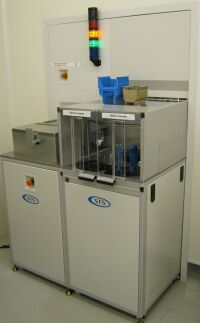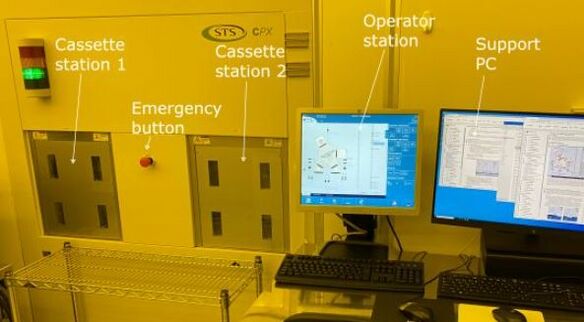Specific Process Knowledge/Etch/DRIE-Pegasus
Feedback to this page: click here
The DRIE Pegasus tools at DTU Nanolab
Unless otherwise stated, all content on this page was created by Jonas Michael-Lindhard, DTU Nanolab
In 2010 DTU Nanolab acquired DRIE-Pegasus 1 (at the time called Danchip and DRIE-Pegasus, respectively). As a state-of-the-art etch tool with excellent performance and great flexibility, it grew immensely popular and by 2015 it was apparent that we needed yet another tool to cope with the demand. Therefore, in 2016 Pegasus 2 was acquired from a closed-down lab and installed next to Pegasus 1.
Looking to expand our dry etching capabilities in 2017 we got an irresistible offer on a twin Pegasus system with cassette to cassette vacuum robot from a commercial fab. The twin Pegasus system (called Pegasus 3 and 4) is installed at the old cluster 2 location in cleanroom C1 and will run only 6" wafers. Pegasus 3 is the 6" silicon etch work horse and Pegasus 4 is converted (adding extra process gases) into a 6" dielectric etch tool that will supplement/replace the AOE.
This page was originally intended as a regular one-machine page (the Pegasus 1 page). However, as of 2018 with several tools, the page will serve as common page for all of our Pegasi with subpages for each tool.
The Bosch process
The DRIE Pegasus tools are state-of-art silicon dry etchers that offer outstanding performance in terms of etch rate, uniformity etc. They use the so-called Bosch process to achieve excellent control of the etched features. Click HERE to access the top of the page. The contents are:
- Description of the Bosch process
- Processing options on the Pegasus
- Modification of the showerhead
- RF matching
- Picoscope process monitoring
As of 2017, completing the Dry Etch TPT course is mandatory for all new users. On the TPT web page you will find a version of the latest lecture slides - here you will find information as well.
Links to the individual pages for the Pegasi
| Equipment | DRIE-Pegasus 1 | DRIE-Pegasus 2 | DRIE-Pegasus 3 | DRIE-Pegasus 4 | ||
|---|---|---|---|---|---|---|
| Purpose | Primary |
|
|
|
| |
| Alternative |
|
|
|
| ||
| Performance | Etch rates |
|
|
|
| |
| Uniformity |
|
|
|
| ||
| Process parameter range | RF powers |
|
|
|
| |
| Gas flows |
|
|
|
| ||
| Pressure and temperature |
|
|
|
| ||
| Process options |
|
|
|
| ||
| Substrates | Sizes |
|
|
|
| |
| Loading |
|
|
| |||
| Allowed materials |
|
|
|
| ||
| Possible masking materials |
|
|
|
| ||
Process information
Process notation
Describing a process recipe on the Pegasus may sometimes be difficult because of the great flexibility of the instrument. A compact and precise notation is therefore required for the recipes. Click HERE to find a short description.
Hardware changes
A few hardware modifications have been made on the Pegasus 1 since it was installed in 2010. The changes are listed in the table below under hardware options.
| DRIE-Pegasus 1 | DRIE-Pegasus 2 | DRIE-Pegasus 3 | DRIE-Pegasus 4 | |
|---|---|---|---|---|
| Manufactured | 2010 | 2010 | 2010 | 2010 |
| Serial | MP0636 | MP0641 | CP0170 | CP0171 |
| Electrode size | 4" | 6" | 6" | 6" |
| Hardware options | ? |
General Pegasus information
Wafer bonding
To find information on how to bond wafers or chips to a carrier wafer, click HERE.
Characterisation of etched trenches
The trenches in deep silicon trenches can be characterized in many ways. Being able to compare processes requires that a set of common measurements and calculations must be established. Click HERE to find more information about the parameters used on the DRIE-Pegasus process development.


